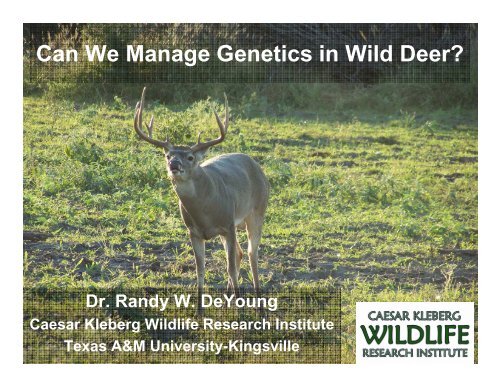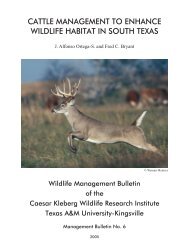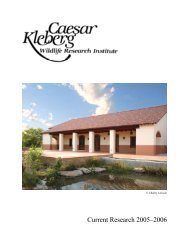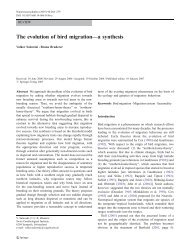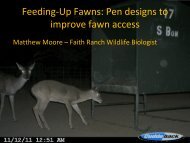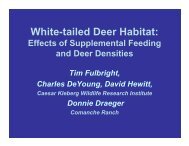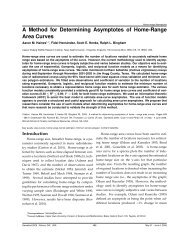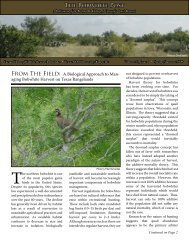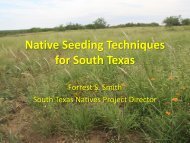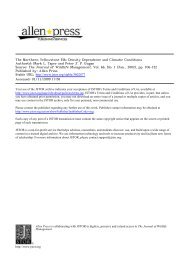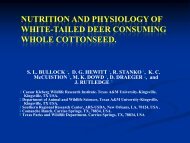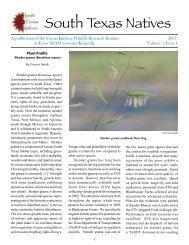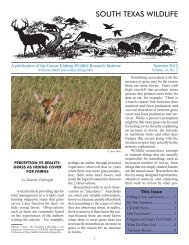You also want an ePaper? Increase the reach of your titles
YUMPU automatically turns print PDFs into web optimized ePapers that Google loves.
Can We Manage Genetics in Wild Deer?Dr. Randy W. DeYoungCaesar Kleberg Wildlife Research InstituteTexas A&M University-Kingsville
Factors Affecting Deer Management• Standard answer:– 3 “equal” componentsGeneticsAgeNutrition
Factors Affecting Deer Management• Recently: focus on genetics onlyGenetics!!!AgeNutrition
Factor Affecting Deer Management• We know about:–Age– NutritionGenetics?Age• How much do we knowabout “Genetics” ???Nutrition
Overview• Regional differences• Lessons fromrestocking• <strong>Breeding</strong> success andselective harvest
Deer Populations Differ• Body size• Antler size• <strong>Breeding</strong> date• Coat color, lengthAdult (same-aged) bucksVenezuelaMichiganBaker (1984)
Antler Size Differences by RegionQuality Deer ManagementAssociationTotal number ofBoone & Crockett,Pope & Young1 - 45 - 2021 - 50> 50
Genetics at a Large Scale• 30 named subspecies• Differ in size, color, etc.• How “real” are thesesubspecies?• How many differencesdue to “genetic” factors?From Baker (1984)
Genetics on a Large ScaleGenetic studies often support fewer uniquegroups than subspecies5 Named subspecies 3 Genetic groupsFrom Honeycutt (2000)
Why do Deer Populations Differ??– Differences among populations• Genetics• Environment(nutrition)– How do we discriminate “genetic” vs.environmental (e.g., nutrition) effects?Paul Brown
Example from Mississippi…Regional Soil QualityHigh• Delta• Loess• Upper Coastal Plain• Lower Coastal Plain• CoastDeltaLoessUCPLCPLowCoast
Regional Variation in Body MassInfluence of soil quality on buck body massSoil regions in MSDressed body mass (lbs)958575655545350.5 1.5 2.5 3.5 4.5 5.5+DeltaUCPLoessLCPCoastAge classStrickland & Demarais (2000)Journal of Wildlife Management 64:903-911
Regional Variation in Antler SizeInfluence of soil quality on buck antler sizeSoil regions in MSAntler size index7565554535251.5 2.5 3.5 4.5 5.5+DeltaUCPLoessLCPCoastAge classStrickland & Demarais (2000)Journal of Wildlife Management 64:903-911
Genetics on a Large Scale– Same trends for doe body weights– Same trends for growth rates of bucks & does• Higher soil quality = faster growthAre these differences due to genetics?Or does soil quality (nutrition) play a large role?
Genetics at a Large Scale• Lessons from deer restocking:– Less than 500 deer in MS in 1929– Trapping and transplanting resulted inpopulation recovery– Some native deer survived– Transplants populated other areasRemnant deer ca. 1929(Leopold 1929)
Genetic Consequences of DeerRestoration in Mississippi• Recovery successful– Populations widely distributed– High genetic diversityUSASH MAL CAL CKWVAINOX• Genetic structuringSUNWAL– Diverse stocksTAL– Native, transplanted deerCHYDeYoung et al. 2003Molecular Ecology 12:3237-3252WIL AMTPSPJCRLFR
Genetic Similarity of CurrentPopulationsUSNFCALCKWASH MAL NOXKRTALJCRCHYPSPJBDASHSUNVAIWALLFRVAICALCKWSUNWILAMTTALUSMALCHYNOXWIL AMTWALPSPJCRLFR
Leaf River Stocks– Leaf River stock• Chickasawhay WMA• Tallahala WMA• Calhoun WMA• Chickasaw WMA• Pine Springs DMAP• Vaiden Hill DMAP– How similar are these?• Body mass•Antler sizeCAL CKWDeltaVAIUCPLoessTALLCPCHYPSP LFRCoast
Results: Antler SizePredicted B&C Score1151059585<strong>Buck</strong>s Aged 3.5 Years+ (1991-1994)LR CHY TAL CHW CAL PSP VHArea** **n = 26 85 49 25 18 25 23*95% CI do not overlap LR
Results: Antler SizeDifference from Leaf River: <strong>Buck</strong>s Aged 3.5 yr+VHPSPCALCHWTALCHY0 5 10 15 20Paul BrownB&C Inches
ASH MALWILAMTSUNVAIUSCALCKWNOXTALCHYPSP LFRJCRWALDeltaLoessConclusionsUCPLCP• Regional basis:– Different genetic stockswithin regions– Yet, physical differencescorrelated with soil qualityCoast
Conclusions• Population basis:– Same genetic stocks in different soil regions– Today, 30-70 years after restocking,biologically meaningful differences• Body weights: 5-14 lbs. for adult does• Antler size: 14-20 B&C inches for adult bucksPaul Brown
Selective Harvest and DeerManagement• How effective?– Selective removal– Selective protection– Introduction• Assumptions of selection– Antler characters heritable– Large-antlered bucks will breed– Can we predict or control breeding??
Deer CSI(live deer)(pretty colors)154 156 178 182 220 246…...(numbers)(deer parts)(PCR: black box)blah, blah blah,DNA blah blahblah DNA…...Results!!!(lab hocus-pocus)
Results:– 439 total deer, 237 fawnsduring 1998-2001– 46 bucks sired 70 fawns
<strong>Buck</strong> <strong>Breeding</strong> <strong>Success</strong> by Age ClassKing RanchPercent90807060504030201002370571419 161.5 2.5 3.5+Age classIn PopulationParentage Assigned
<strong>Buck</strong> <strong>Breeding</strong> <strong>Success</strong> by Antler SizeKing RanchNo. <strong>Buck</strong>s141210864200-1021-3041-50Avg in population<strong>Breeding</strong>46 <strong>Buck</strong>s27 with antlerscores61-7081-90101-110121-130141-150161-170Gross B&C Score
Young <strong>Buck</strong>s <strong>Breeding</strong>?!Frequency7654321Median Dec 9th3.5+2.51.5020-Nov 27-Nov 4-Dec 11-Dec 18-Dec 25-Dec 1-Jan 8-JanConception Date
Multiple Paternity?!• King Ranch, 2000–2002– 51 twin, triplet litters– 12 multiple paternity (23.5%)
Conception Dates: King RanchMP: 4 DecNo MP: 7 Dec**No late-season evaluation3530Frequency25201510no MPMP50Dec 22-28Dec 15-21Dec 8-14Dec 1-7Nov 24-30Nov 17-23Conception Interval (Weekly)
Why are so many bucks breeding?– “Tending bond”• 1 buck, 1 doe• <strong>Buck</strong> stays with 1 doe 24-48 hrs– No herds or “harems”– No territories
Why are so many bucks breeding?• Does live in small groups• <strong>Buck</strong>s chase individual does• Most does bred in 2-4 weeks
Why are so many bucks breeding?Dominance is probably important unlessyou are the only one to find that doeFewer chances to exert dominance if youhave to court individual does
Why are so many bucks breeding?• Competition among bucks• “Sneaky” tactics• Tending buck replaced by dominant buck
Why are so many bucks breeding?• Competition– Changes over time• How many does in estrous at 1 time?– More competition during early, late rut– What happens if you affect the number ofcompetitors through harvest, etc??
<strong>Breeding</strong> Behaviors• Response to local conditions• <strong>Buck</strong> breeding success depends on…– Degree of competition (fighting)• Resources• Does• Age structure, buck:doe ratio• Population density
<strong>Breeding</strong> Behaviors• <strong>Buck</strong> breeding success depends on…– <strong>Buck</strong> age– <strong>Buck</strong> body condition– May vary if conditions change– How much control can we exert on thesystem through management?
Prospects for ManagementIn many cases, selective harvest or introductionplans will be highly inefficient for changingpopulation genetic characters– Many different bucks are breeding– Most successful bucks will have few fawns– Can not predict successful breeders on the basis ofantler characteristics
Remaining Unknowns• What are the effects of more extrememanagement strategies?– High fencing of “small” properties– Distribution of breeding changes in small areas• Single bucks can monopolize breeding• Potential for inbreeding?• Predictability is still a problem- who breeds??
Remaining Unknowns• Why are some bucks more successful?• Individual deer differ widely in movementpatterns and activity level- is this related tobreeding success?
Remaining Unknowns• Why do some bucks breed early in life, whileothers breed later or not at all?• What about doe movements? Are doescompletely passive or do they “choose” bucks?
14000120001000080006000400020000220131111111111111212121212111111222Month22013Distance Moved (m/day)
250002000015000100005000022040111111111212121212121111122222Month22040Distance Moved (m/day
2000018000160001400012000100008000600040002000012023111111111212121212121111122222Month12023Distance Moved (m/day)
2500020000150001000050000220411111111212121212121111112222Month22041Distance moved (m/day)
With theSupport andAssistance of:Rob and Bessie WelderWildlife Research and Education
Questions??


